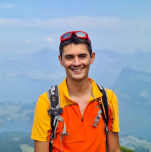Mathieu BERGER
|
Mathieu Berger has been a contract associate professor in exercise physiology and adapted physical activities in the Sport Sciences Department at Jean Monnet University in Saint-Etienne since October 2023 and will be the program director of the International Health and Performance Science (HPS) Master in 2024. He obtained his PhD in 2018 (Université de Lyon / Saint-Etienne) and then completed a 1st postdoc position at the Center for Investigation Research in Sleep at the University Hospital of Lausanne, Switzerland (2018-2021) followed by a 2nd postdoc position at the Sleep and Vigilance Center of the Hôtel Dieu Paris (2022-2023). He got his accreditation to supervise research (HDR) in 2023. Mathieu's main clinical research activities aim to study the health effects of physical activity in primary and secondary prevention, and to evaluate the effect of different interventions (physical activity, nutrition, medication, napping) on sleep and cardiovascular risk in sleep apnea patients and shift workers. In parallel, Mathieu is also developing an epidemiological activity in search of early biomarkers of cardiovascular risk identifiable during sleep. Its integration within the LIBM should be associated with the implementation of new projects on the impact of sleep on sports performance in the coming years. All his research activities have received extensive financial support (over €760k as of October 2023). Mathieu has received a Thesis Excellence Award from the University of Saint-Etienne and a Young Investigator Award from the World Sleep Society. As of October 2023, Mathieu had published 32 articles (H-index 10) in international peer-reviewed journals, and signed nearly 60% of his publications in a significant rank (1st,2nd or last author). He is currently supervising 2 PhD students. |
Mathieu BERGER (mathieu.berger @ univ-st-etienne.fr)
Institution Université Jean Monnet (Saint Etienne) Team: [PAF] Position Associate professor
Publications |
1. Patients with severe obstructive sleep apnea have decreased exercise capacity (VO2max) (Berger et al. Sleep Med Reviews 2019, https://doi.org/10.1016/j.smrv.2019.03.002). 2. A 9-month community-based physical activity program reduces the severity of obstructive sleep apnea by 20%, and could be used for prevention in moderate forms of OSA (Berger et al. European Respiratory Journal 2018, https://doi.org/10.1183/13993003.01592-2018). 3. This physical activity program also slows the decline in autonomic activity in patients with obstructive sleep apnea (Berger et al. Scandinavian Journal of Medicine and Sciences in Sports 2019, https://doi.org/10.1111/sms.13447). 4. Improvement in sleep apnea severity remains transient if physical activity is not maintained regularly over the long term (Berger et al. Scandinavian Journal of Medicine and Sciences in Sports 2021, https://doi.org/10.1111/sms.13961). 5. Heart rate variability (HRV) parameters extracted from night polysomnography are associated with cardiovascular risk 5 years later (Berger et al. Heart Rhythm 2022, https://doi.org/10.1016/j.hrthm.2021.11.033). 6. Fine features of sleep microstructure are associated with the incidence of hypertension at 5 years (Berger et al. Journal of American Heart Association 2022, https://doi.org/10.1161/JAHA.121.025828). 7. Light-intensity physical activity already has health benefits in subjects over 65 y, with a 30% reduction in mortality (Dupré et al. Frontiers Public Health 2023, https://doi.org/10.3389/fpubh.2023.1182552). | |



